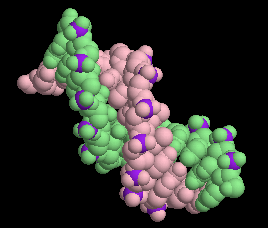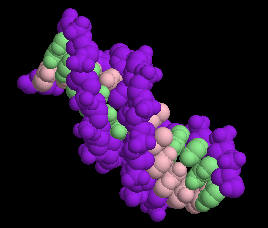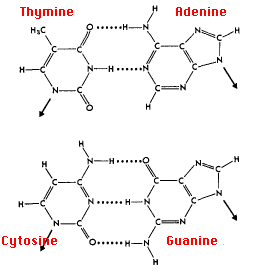

We've heard all about cells and proteins, so where does DNA come in?
DNA (Deoxyribose Nucleic Acid) is an information store. DNA itself doesn't perform any functions in the cell, but it has a code which specifies how all the proteins are made.
DNA is a very long thin molecule made up of just 4 building blocks or 'bases' called adenine (A), thymine (T), cytosine (C) and guanine (G).
A DNA molecule consists of two such molecule strands wound around eachother in a 'double helix'.
 |
 |
| Here's a picture of a short stretch of the double helix. One of the strands is shown in green and the other in pink. Each strand consists of a 'backbone' with the 'bases' hanging off it. Imagine a washing-line as the backbone with the clothes hanging off it as the bases. In this picture I have coloured the clothes pegs in purple. | In this picture I've coloured it slightly differently. This time I've coloured the backbone (the 'washing line') in purple and the bases ('clothes') on one strand in green and those on the other strand in pink. |
The bases pair with one another is a specific way rather like plugs and sockets. Adenine (A) will only pair with thymine (T), while cytosine (C) will only pair with guanine (G).
Here is a detailed picture which shows the interactions between the bases at an atomic level:

We'll see why this is important and how DNA codes for proteins in a minute.
On the Next Page we will see some actual DNA!